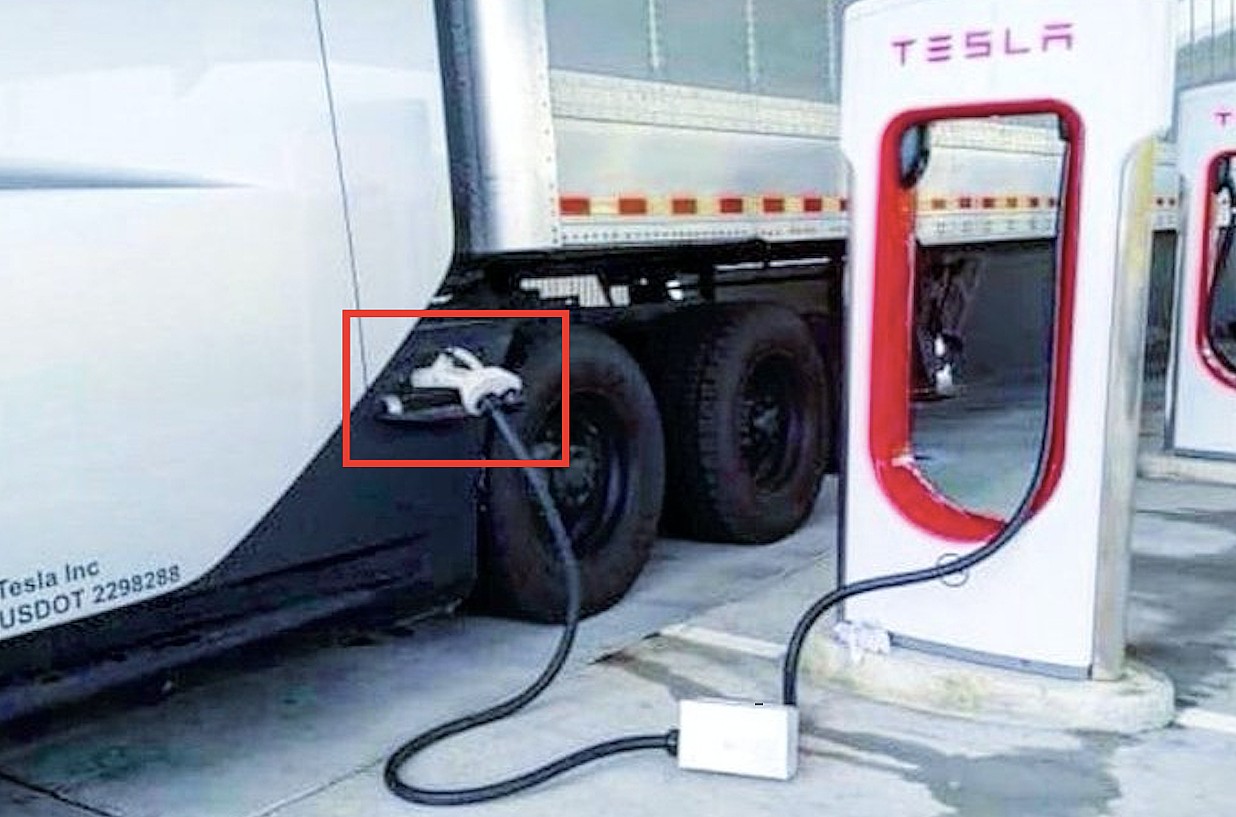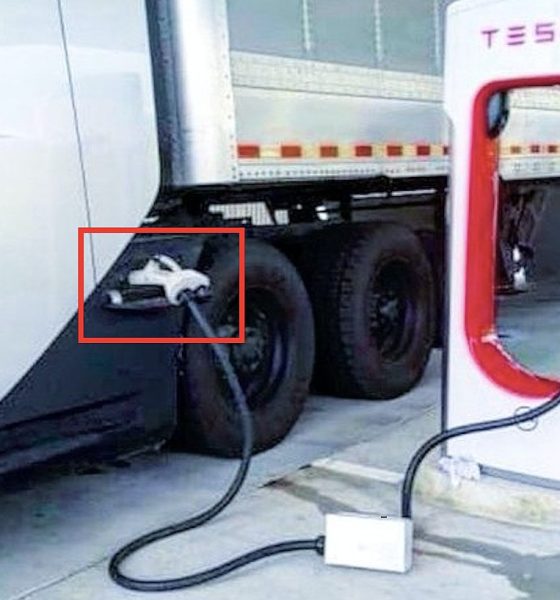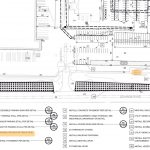

News
Tesla’s first-ever Semi ‘Megacharger’ to be installed at Frito-Lay’s Modesto plant
Tesla’s first-ever ‘Megacharger’ for the all-electric Semi will be installed at Frito-Lay’s Modesto, California plant, according to documents.
After being unveiled in November 2017, Tesla received hundreds of pre-orders for the Semi, its first all-electric commercial vehicle. Frito-Lay was one of the first, as its parent company, PepsiCo, reserved 100 Tesla Semis on December 12th, 2017.
Earlier this year, it was revealed that Frito-Lay would be receiving 15 Tesla Semis before the end of 2021. It was a massive announcement because Tesla has delayed the Semi project on several occasions due to battery constraints. Tesla CEO Elon Musk announced last year to company employees in a leaked email that it was time to begin “volume production” of the Semi. However, nothing really ever came of it because the demand for Tesla’s passenger vehicles was through the roof. Instead, the automaker chose to focus on ramping up the production of the Model 3 and Model Y and expanding its production footprint to Europe and Texas.
Now, documents reveal that Frito-Lay is planning for the imminent delivery of the Tesla Semi units. @MarcoRPTesla uncovered several planning documents that indicate Frito-Lay will install the first-ever Tesla Semi Megacharger at its Modesto, California, plant. According to the documents, Frito-Lay is also plotting out some space for designated parking areas for the Tesla Semi.
- Credit: Twitter | @MarcoRPTesla
- Credit: Twitter | @MarcoRPTesla
It was first reported on Saturday, May 22nd, by DriveTeslaCanada that Frito-Lay would be installing the first Megacharger on-site at the Modesto facility.
The Megacharger was first announced at the Semi’s unveiling event in late 2017. Musk said that Tesla would implement a worldwide network of Megachargers that would be solar-powered and would provide 400 miles of range in only 30 minutes of charging. This would be accomplished due to an output of over one megawatt. Due to the excessive output of energy, Tesla also filed a patent in late 2019 for a liquid-cooled charging connector, similar to those used in Tesla’s V3 Superchargers.
Tesla confirmed during the Q1 2021 Earnings Call that Semi production would begin later this year. After announcing that production would begin in late 2020, Tesla pushed back the anticipated start dates of production due to battery worries. “Demand is no problem, but near-term cell supply makes it hard to scale Semi,” Musk said in March 2021. “This limitation will be less onerous next year.”
The CEO also commented on the demand during the Q3 2020 Earnings Call, where he said:
“We need to solve the cell constraint before ramping Semi to significant volume. That’s the only real constraint on Semi’s progress.”
Because of the looming installation of the first-ever Megacharger, it appears that the Tesla Semi will make its way to Frito-Lay as expected later this year.
What do you think? Let us know in the comments below, or be sure to email me at joey@teslarati.com or on Twitter @KlenderJoey.

News
Nvidia CEO Jensen Huang explains difference between Tesla FSD and Alpamayo
“Tesla’s FSD stack is completely world-class,” the Nvidia CEO said.

NVIDIA CEO Jensen Huang has offered high praise for Tesla’s Full Self-Driving (FSD) system during a Q&A at CES 2026, calling it “world-class” and “state-of-the-art” in design, training, and performance.
More importantly, he also shared some insights about the key differences between FSD and Nvidia’s recently announced Alpamayo system.
Jensen Huang’s praise for Tesla FSD
Nvidia made headlines at CES following its announcement of Alpamayo, which uses artificial intelligence to accelerate the development of autonomous driving solutions. Due to its focus on AI, many started speculating that Alpamayo would be a direct rival to FSD. This was somewhat addressed by Elon Musk, who predicted that “they will find that it’s easy to get to 99% and then super hard to solve the long tail of the distribution.”
During his Q&A, Nvidia CEO Jensen Huang was asked about the difference between FSD and Alpamayo. His response was extensive:
“Tesla’s FSD stack is completely world-class. They’ve been working on it for quite some time. It’s world-class not only in the number of miles it’s accumulated, but in the way it’s designed, the way they do training, data collection, curation, synthetic data generation, and all of their simulation technologies.
“Of course, the latest generation is end-to-end Full Self-Driving—meaning it’s one large model trained end to end. And so… Elon’s AD system is, in every way, 100% state-of-the-art. I’m really quite impressed by the technology. I have it, and I drive it in our house, and it works incredibly well,” the Nvidia CEO said.
Nvidia’s platform approach vs Tesla’s integration
Huang also stated that Nvidia’s Alpamayo system was built around a fundamentally different philosophy from Tesla’s. Rather than developing self-driving cars itself, Nvidia supplies the full autonomous technology stack for other companies to use.
“Nvidia doesn’t build self-driving cars. We build the full stack so others can,” Huang said, explaining that Nvidia provides separate systems for training, simulation, and in-vehicle computing, all supported by shared software.
He added that customers can adopt as much or as little of the platform as they need, noting that Nvidia works across the industry, including with Tesla on training systems and companies like Waymo, XPeng, and Nuro on vehicle computing.
“So our system is really quite pervasive because we’re a technology platform provider. That’s the primary difference. There’s no question in our mind that, of the billion cars on the road today, in another 10 years’ time, hundreds of millions of them will have great autonomous capability. This is likely one of the largest, fastest-growing technology industries over the next decade.”
He also emphasized Nvidia’s open approach, saying the company open-sources its models and helps partners train their own systems. “We’re not a self-driving car company. We’re enabling the autonomous industry,” Huang said.
Elon Musk
Elon Musk confirms xAI’s purchase of five 380 MW natural gas turbines
The deal, which was confirmed by Musk on X, highlights xAI’s effort to aggressively scale its operations.

xAI, Elon Musk’s artificial intelligence startup, has purchased five additional 380 MW natural gas turbines from South Korea’s Doosan Enerbility to power its growing supercomputer clusters.
The deal, which was confirmed by Musk on X, highlights xAI’s effort to aggressively scale its operations.
xAI’s turbine deal details
News of xAI’s new turbines was shared on social media platform X, with user @SemiAnalysis_ stating that the turbines were produced by South Korea’s Doosan Enerbility. As noted in an Asian Business Daily report, Doosan Enerbility announced last October that it signed a contract to supply two 380 MW gas turbines for a major U.S. tech company. Doosan later noted in December that it secured an order for three more 380 MW gas turbines.
As per the X user, the gas turbines would power an additional 600,000+ GB200 NVL72 equivalent size cluster. This should make xAI’s facilities among the largest in the world. In a reply, Elon Musk confirmed that xAI did purchase the turbines. “True,” Musk wrote in a post on X.
xAI’s ambitions
Recent reports have indicated that xAI closed an upsized $20 billion Series E funding round, exceeding the initial $15 billion target to fuel rapid infrastructure scaling and AI product development. The funding, as per the AI startup, “will accelerate our world-leading infrastructure buildout, enable the rapid development and deployment of transformative AI products.”
The company also teased the rollout of its upcoming frontier AI model. “Looking ahead, Grok 5 is currently in training, and we are focused on launching innovative new consumer and enterprise products that harness the power of Grok, Colossus, and 𝕏 to transform how we live, work, and play,” xAI wrote in a post on its website.
Elon Musk
Elon Musk’s xAI closes upsized $20B Series E funding round
xAI announced the investment round in a post on its official website.

xAI has closed an upsized $20 billion Series E funding round, exceeding the initial $15 billion target to fuel rapid infrastructure scaling and AI product development.
xAI announced the investment round in a post on its official website.
A $20 billion Series E round
As noted by the artificial intelligence startup in its post, the Series E funding round attracted a diverse group of investors, including Valor Equity Partners, Stepstone Group, Fidelity Management & Research Company, Qatar Investment Authority, MGX, and Baron Capital Group, among others.
Strategic partners NVIDIA and Cisco Investments also continued support for building the world’s largest GPU clusters.
As xAI stated, “This financing will accelerate our world-leading infrastructure buildout, enable the rapid development and deployment of transformative AI products reaching billions of users, and fuel groundbreaking research advancing xAI’s core mission: Understanding the Universe.”
xAI’s core mission
Th Series E funding builds on xAI’s previous rounds, powering Grok advancements and massive compute expansions like the Memphis supercluster. The upsized demand reflects growing recognition of xAI’s potential in frontier AI.
xAI also highlighted several of its breakthroughs in 2025, from the buildout of Colossus I and II, which ended with over 1 million H100 GPU equivalents, and the rollout of the Grok 4 Series, Grok Voice, and Grok Imagine, among others. The company also confirmed that work is already underway to train the flagship large language model’s next iteration, Grok 5.
“Looking ahead, Grok 5 is currently in training, and we are focused on launching innovative new consumer and enterprise products that harness the power of Grok, Colossus, and 𝕏 to transform how we live, work, and play,” xAI wrote.










